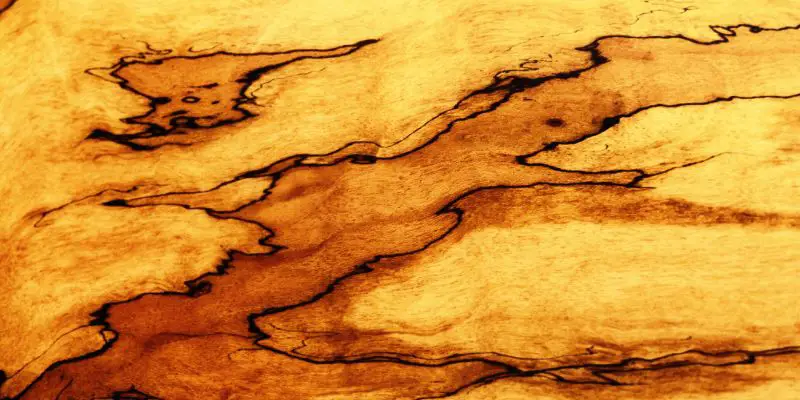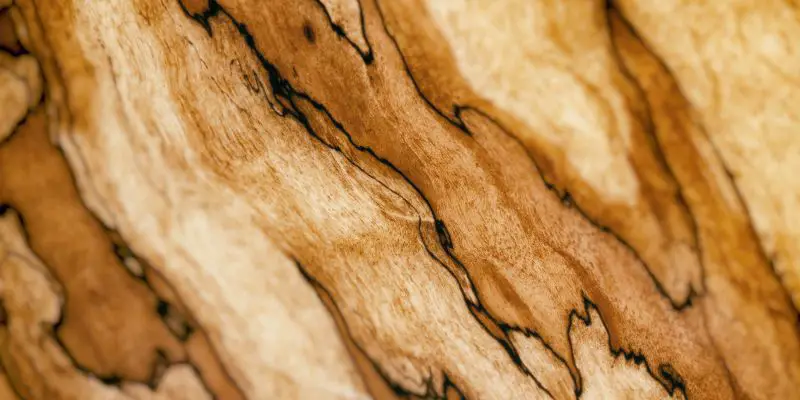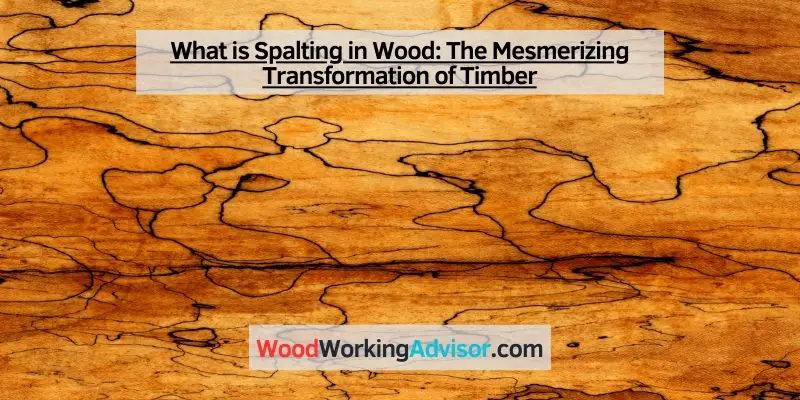Spalting in wood refers to the discoloration or pattern alteration caused by fungi growth. Wood spalted by fungi shows unique colors and designs.
Woodworkers and artisans often seek wood that has undergone spalting due to its aesthetically pleasing appearance. Spalting occurs when fungi invade the wood and begin to break it down, leaving behind distinctive dark lines and pigments. This process can produce stunning and intricate patterns, making spalted wood highly desirable for creating decorative items, furniture, and artistic crafts.
While spalting may weaken the wood’s structural integrity, it adds character and uniqueness to the finished product. Proper processing and treatment can help preserve the beauty of spalted wood, making it a cherished choice among wood enthusiasts and artisans.
Introduction To Spalting
The introduction to spalting is essential in understanding this unique and beautiful phenomenon that occurs in wood. Spalting refers to the process in which wood undergoes coloration and pattern changes due to the growth of fungi. This natural occurrence not only enhances the aesthetic appeal of the wood but also adds value to it. Let’s delve deeper into the definition, history, origins, and various types of spalting.
Definition Of Spalting
Spalting is the fascinating transformation that takes place within wood when certain fungi colonize it. These fungi create intricate patterns, streaks, and color variations, lending a remarkably appealing visual aspect to the wood. Although it is a natural process, spalting can also be induced artificially in controlled environments, resulting in unique designs and colors.
History And Origins Of Spalting
The discovery of spalting can be traced back to ancient civilizations, where craftsmen and woodworkers began noticing the markings and patterns that fungi created within wood. Indigenous tribes used spalted wood for various purposes, including constructing tools, weapons, and intricate decorative pieces.
Nowadays, spalting has gained popularity among woodworkers and artists who appreciate the distinctive beauty it adds to their creations. This technique has gradually evolved from an ancient craft to a recognized art form, with professionals experimenting with different methods to achieve desired effects.
Types Of Spalting
Spalting manifests in different forms, depending on the types of fungi present and the conditions under which the wood is exposed. Here are some of the most common types of spalting:
- Zone Lines: Also known as barriers, these are demarcation lines within spalted wood that separate the colonized and uncolonized sections. These lines often appear as dark bands, adding depth and character to the wood.
- Radial Lines: These lines radiate outward from the center of the spalted area, often resembling rays of light. They create a mesmerizing effect and enhance the visual appeal of the wood.
- Pseudo-Spalted Wood: In some cases, wood may exhibit markings and patterns that resemble spalting but are not caused by fungi. This phenomenon is termed pseudo-spalted wood and can occur due to other factors such as insect infestation, weathering, or natural aging processes.
- Fruit Bodies: Some spalting fungi produce fruiting bodies, also known as mushrooms, which can appear on the surface of the wood. These mushrooms may bear various colors and sizes, further contributing to the unique aesthetics of spalted wood.
Understanding the different types of spalting allows craftsmen, artists, and wood enthusiasts to experiment with various effects and designs to create stunning and one-of-a-kind pieces.

The Spalting Process
Spalting is a fascinating natural wood process that occurs when fungi start to interact with the wood, creating unique patterns and colors. It adds a beautiful and artistic touch to wooden objects.
Introduction: The Spalting Process
Wood spalting refers to the intricate and visually appealing patterns that can occur in certain types of wood. This fascinating process is a result of a combination of factors, including fungal involvement, environmental conditions, and the duration of exposure. In this section, we will delve into each of these aspects in detail. Understanding the spalting process not only enhances our appreciation for this natural phenomenon but also provides valuable insights for woodworkers and artisans seeking to incorporate spalted wood into their creations.
Fungal Involvement
Fungi play a crucial role in the spalting process, transforming the appearance of wood through their intricate network of mycelium. As the fungi colonize the wood, they release enzymes that break down the cell walls, resulting in the characteristic dark lines and streaks. These fungal activities not only alter the wood’s color but also contribute to its overall stability and durability.
The specific types of fungi involved in spalting can vary, but some common species include the white-rot fungi, such as Trametes versicolor, and the brown-rot fungi, such as Gloeophyllum sepiarium. Each type of fungus has its own unique effect on the wood, leading to a range of patterns and hues.
Environmental Factors
Apart from fungal involvement, environmental conditions also significantly impact the spalting process. Moisture and temperature play a vital role in creating the ideal environment for fungi to thrive and colonize the wood. For example, high humidity levels and moderate temperatures provide optimal conditions for fungal growth, increasing the likelihood of spalting. The presence of oxygen is another crucial factor, as it enables the fungi to metabolize and break down the wood’s components.
In addition to these factors, the type of wood itself can influence the extent and pattern of spalting. Some woods are more susceptible to fungal colonization and exhibit more pronounced spalting patterns. By understanding the environmental factors that contribute to spalting, woodworkers can better control and manipulate these conditions to achieve desired effects.
Duration And Stages Of Spalting
The spalting process is not instantaneous but occurs over a certain period of time. The duration of spalting can vary widely, ranging from a few weeks to several months, depending on the wood species, fungal activity, and environmental conditions. During this time, the wood undergoes distinct stages, each characterized by different patterns and color changes.
In the early stages of spalting, known as the incubation period, the fungi establish their presence and begin to colonize the wood. This is followed by the active phase, where the fungi consume the wood’s nutrients, resulting in the formation of the characteristic dark lines and zones. Finally, in the advanced stage, the spalting patterns become more pronounced and intricate, creating captivating visual effects.
Overall, understanding the duration and stages of spalting allows woodworkers to strategically plan and harvest wood when it reaches the desired level of spalting. This knowledge empowers artisans to harness the natural beauty of spalted wood in their creations, whether it be furniture, decorative objects, or musical instruments.
In conclusion, the spalting process involves fungal involvement, environmental factors, and a distinct progression of stages. By comprehending these elements, we gain insight into the remarkable phenomenon of spalting and can harness its beauty in our woodworking endeavors.
Applications And Benefits Of Spalted Wood
Spalted wood is a unique type of wood coveted by craftsmen and artisans for its intricate patterns and stunning visual appeal. Not only does it bring a rustic and artistic touch to furniture and decorative items, but spalted wood also offers several practical benefits that make it highly sought after in various industries. In this section, we will explore the applications and benefits of spalted wood in terms of aesthetics, durability, and market demand.
Aesthetics And Visual Appeal
One of the primary reasons why spalted wood is so highly regarded is its outstanding aesthetics and visual appeal. The natural processes that occur during the spalting process, such as fungal growth and decay, create mesmerizing patterns and colors in the wood. These patterns often resemble intricate marbling, black lines, and streaks that give each piece of spalted wood a distinct and unique personality.
Whether used in furniture, flooring, or decorative accents, spalted wood adds a touch of natural beauty and artistic flair to any space. It is particularly popular among interior designers and homeowners looking to create a visually striking and conversation-worthy focal point in their living areas. From coffee tables and bookshelves to wall art and picture frames, the uses of spalted wood are limited only by imagination.
Increased Durability
In addition to its aesthetic appeal, spalted wood offers increased durability compared to non-spalted wood. The natural processes that occur during spalting, such as fungal colonization, actually strengthen the wood fibers and increase their resistance to decay. This results in a more robust and long-lasting material that can withstand the test of time.
Spalted wood is particularly suitable for outdoor applications such as decking and fencing, where exposure to the elements can cause traditional wood to deteriorate quickly. Its enhanced durability makes it highly sought after by contractors and homeowners looking for a sustainable and durable alternative to regular wood.
Value And Market Demand
The unique beauty and increased durability of spalted wood have led to a significant demand in various industries. Craftsmen and artisans value spalted wood for its artistic potential and use it to create high-end furniture, sculptural pieces, and even musical instruments. The scarcity and labor-intensive nature of spalted wood also contribute to its market value, making it an excellent investment for collectors and enthusiasts.
| Applications of Spalted Wood | Benefits of Spalted Wood |
|---|---|
| High-End Furniture | Aesthetically pleasing |
| Decorative Accents | Increased durability |
| Sculptural Pieces | Market demand and value |
| Musical Instruments |
Whether used in the creation of stunning furniture pieces or cherished as a collector’s item, spalted wood holds a special place in the hearts of artisans and enthusiasts alike. Its applications and benefits extend beyond its visual appeal, making it a valuable and versatile material that continues to captivate and inspire.

Frequently Asked Questions Of What Is Spalting In Wood
How Do You Induce Spalting In Wood?
To induce spalting in wood, you can follow a simple process. First, expose the wood to moisture and high humidity. Second, introduce fungi to the wood by using spore-loaded wood chips or by collecting spores from existing spalted wood. Next, seal the wood in a plastic bag to retain moisture.
Finally, wait for the fungi to grow and create the desired spalting patterns.
Is Spalted Wood More Expensive?
Yes, spalted wood is typically more expensive due to its unique and visually appealing patterns caused by fungi.
How Do You Stop Wood Spalting?
To stop wood spalting, follow these steps: Keep the wood dry and well-ventilated. Avoid exposing it to extreme humidity or temperature. Apply a protective sealant or finish to the wood. Use a wood stabilizing solution to strengthen the fibers. Store the wood in a stable environment.
How Long Does It Take For Wood To Spalt?
Wood can spalt in as little as a few weeks or as long as several months, depending on various factors. These include the type of wood, moisture content, and environmental conditions. It is a natural process where fungi break down the wood fibers, resulting in unique and visually appealing patterns.
Conclusion
Spalting in wood is a fascinating natural process that results in unique and visually appealing patterns. It occurs when fungi invade the wood, causing color variations and intricate lines. By understanding the factors that contribute to spalting, woodworkers and enthusiasts can unlock the potential for creating stunning and one-of-a-kind pieces.
Incorporating spalted wood can add depth and character to furniture, flooring, and decorative items. Explore and embrace the beauty of spalting to elevate your woodworking projects to the next level.


